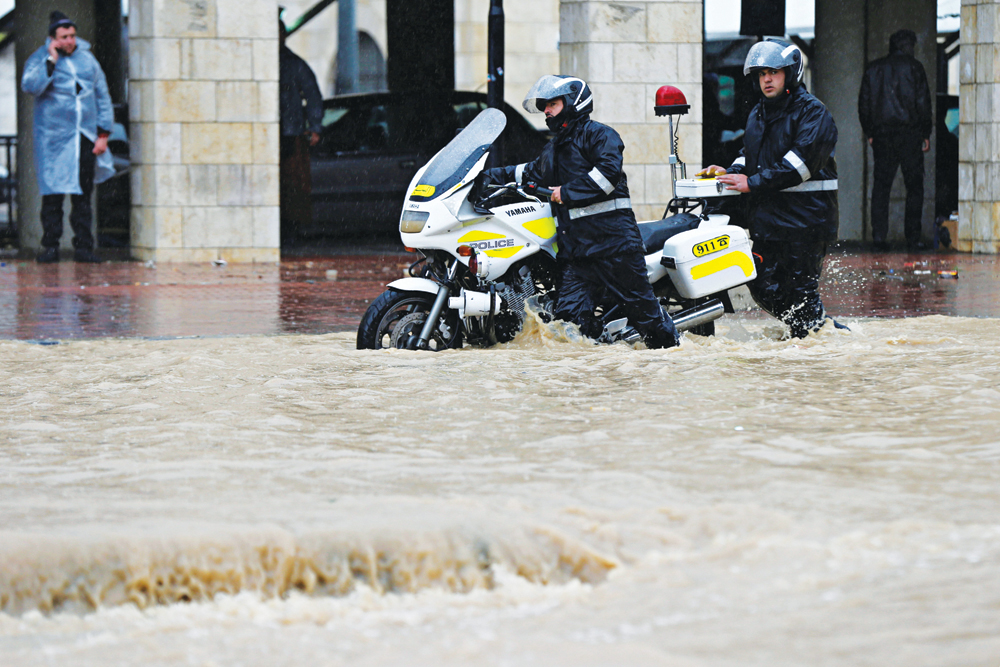DUBAI: Unstable weather conditions across the Middle East and North Africa (MENA) have left residents and experts wondering why spring in the region has felt more like winter.
From cloud seeding to climate change, a number of reasons have been attributed to the storms, rainfall and lightning that have hit the region this month.
“It’s usually warmer in April. This isn’t familiar weather in this period,” said Dr. Ahmad Habib, a meteorological expert at the National Center of Meteorology in the UAE. “It’s a period of instability for all the region.”
Last month, the Saudi General Authority for Meteorology and Environmental Protection warned of thunderstorms, dust and active winds in the southwestern city of Najran and the western city of Al-Baha.
Citizens and residents were warned of wind and dust limiting visibility, with a chance of rain and clouds in the Tabuk region, including coastal areas.
Climate experts have called the sudden change in weather “exceptional” compared to the last three years of dryness witnessed across MENA. Last week, several parts of Tunisia were hit by snow and torrential rainfall, causing fatalities. Floods and colder temperatures were also felt throughout the Levant.

“This April was exceptional in many countries, like the snow that hit Tunisia … We feel it’s exceptional because the last three years have been three successive dry years in North Africa,” said Dr. Karim Bergaoui, a climate and water-modeling scientist at the International Center for Biosaline Agriculture in Dubai.
“It has been a very cold and rainy year, even in Jordan, where there were a lot of floods. This year was exceptionally wet.”
Rainfall and humidity have been high across much of the Middle East, particularly in the Arabian Peninsula, according to the ECMWF Copernicus Climate Change Service.
“The differences we’ve experienced are the result of high-level atmospheric conditions, which have brought predominantly low pressure systems over MENA,” said Dr. Rachael McDonnell, global fellow at the Daugherty Water for Food Institute at the University of Nebraska.
“This ensures that rain-bearing weather frontal systems are drawn along this area, so bringing the rain,” she added. “Normally these frontal systems are over northwest Europe, but this year they’re more southerly because the jet stream is further south.”
While Bergaoui called for more analysis, he said climate change could be one of the causes of such unstable weather conditions in the region. “We know from a climatological point of view that the sea surface temperature really affects the convective system (a collection of thunderstorms that act as a system) here, so it might be one of the causes. We need to study the sea surface temperature in the Gulf,” he added.
Dr. Taoufik Ksiksi, associate professor of biology at United Arab Emirates University, said: “We can be sure that when these extreme events become more frequent and more intense, it can be attributed to a change in climate.”

Traffic policemen push a motorcycle through a flooded street during heavy rains in Amman, Jordan, on Feb. 28, 2019. (Reuters)
He added: “We’re using more fossil fuels, and we aren’t relying enough on renewable energy. We’re changing land use from a natural ecosystem to a human-made ecosystem, and we aren’t energy efficient anymore in transportation. There are very good attempts in the UAE and Saudi Arabia to change the electricity supply from coal to gas, which is a big step, but we need to do more.”
Ksiksi said: “The weather is unusual in North Africa and West Asia … Such extreme weather events, whether it’s very intense snow or rain, are out of season. You see snow in relatively mild weather periods, and floods, dust storms and colder temperatures in some parts of northern Saudi Arabia, Lebanon and parts of Syria, all of which are very likely the outcome of this changing climate and increased greenhouse gases.”
He added: “It has to be a common effort. We need to do more because our environmental ecosystems are fragile. We have the resources, scientifically and financially, to do something about it.”
Johnny Bowen of outdoor clothing company Great British Outfitters noted a 26 percent increase in sales of winter clothing in the region during the first quarter of 2019 compared to the same period last year.
“Last month, there was a surge in sales of rainproof jackets to the UAE,” he said. “Often, the sales come when people from the UAE are going on holidays where the climate is colder. This year, we’re seeing them buy jumpers and jackets to wear in the UAE … It has been really unusual.”













